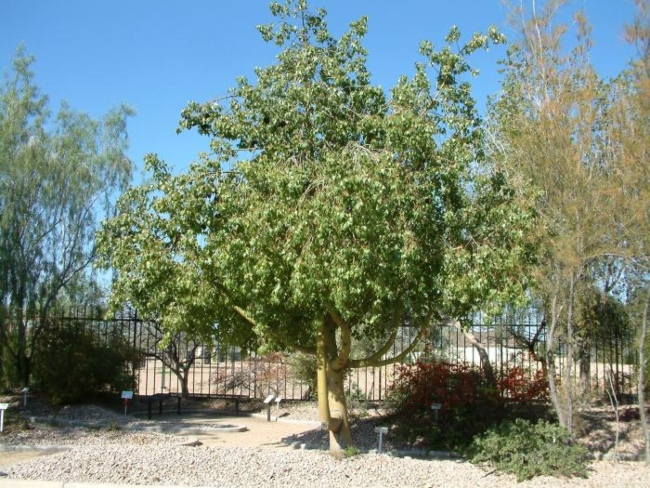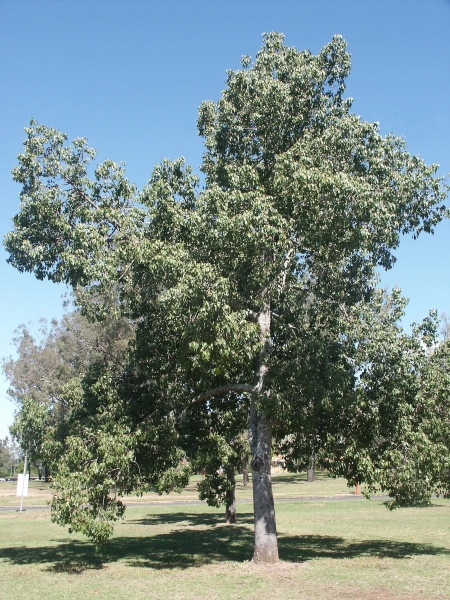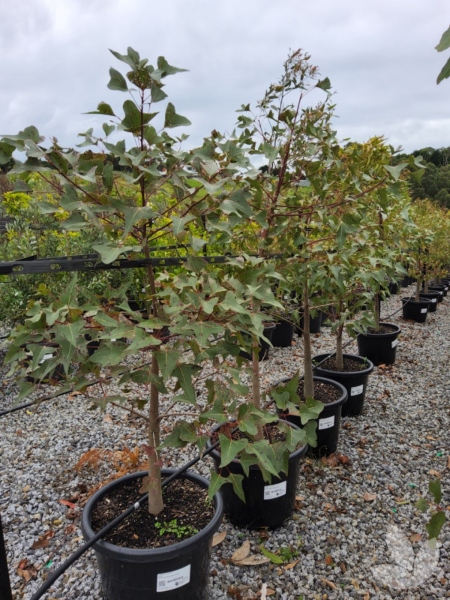The Kurrajong tree being native to Australia, is often seen planted as a street tree. I marvel at the height of these trees and the flowers that arrive in spring, shaped like a bell in shades of white and pink.
In our guide, we’ll explore some of the varieties of Brachychiton populneus, how to propagate the tree, and then how to best care for it. Learn about the pests and diseases that you might have to deal with and learn more about this Australian native.
More...

Source: Tri-Valley Water-Wise Gardening
Family: | Malvaceae |
|---|---|
Genus: | Brachychiton |
Species: | B. populneus |
Origin: | Australia |
Common Names: | Kurrajong tree |
Location: | Indoor and outdoor |
Type: | Tree |
Growth: | Up to 14 metres tall and 6 metres wide |
Sun requirements: | Full sun |
Foliage Colour: | Green |
Flower Colour: | Pink, white |
Flowering: | Spring |
Edible Parts: | Seeds, tap root |
Maintenance level: | Average |
Poisonous for pets: | Yes |
Introduction to the Kurrajong Tree

The Kurrajong tree or Brachychiton populneus is an impressive evergreen tree. It’s known for having simple water needs and being drought tolerant, loving the full sun but needing well-draining soil for optimum health.
These trees are upright in shape when they are young and then become more rounded when they mature. The glossy green leaves of the Kurrajong tree shimmer when it’s windy in the same way that poplar trees do. Brachychiton populneus produces flowers generously and these are followed by big bunches of wooden seed pods.
If you wanted to see the Kurrajong tree in its natural habitat, you would find it in eastern Australia growing in mostly rocky soil, enjoying the warm climate and not being phased when seasonal drought comes along.
Perhaps this is why it works well as a tree planted along streets and in parks, offering wonderful shade.
Kurrajong Tree Varieties
Brachychiton populneus x acerifolius ‘Jerilderie Red’ – this is a small tree that reaches a maximum height of 8 metres and a similar width. The leaves are glossy and green and the flowers are a brilliant bright red.
Brachychiton populneus x acerifolius ‘Bella Pink’ - this is a hybrid of Brachychiton populneus and Brachychiton acerifolius. The flowers are salmon pink and it has a compact shape.
Brachychiton populneus x acerifolius ‘Bella Donna’ – this hybrid variety is shaped like a pyramid with pink flowers. New leaf growth is a bright red and then the leaves become green as they get older.
Brachychiton populneus x discolor ‘Griffith Pink’ – this is a hybrid of Brachychiton populneus and Brachychiton discolor. It’s similar to Brachychiton populneus x acerifolius ‘Bella Donna’, also having a pyramid shape and plenty of pink blooms. The big leaves help to create a dense canopy to provide plenty of shade.
How to Grow Kurrajong Tree

Source: Paten Park Native Nursery
Ideal Conditions for Planting Kurrajong Tree
Sunlight and Temperature Preference
The Kurrajong tree enjoys full sun. It doesn’t like being shaded by trees or buildings. Kurrajong trees can tolerate cooler temperatures but they prefer temperatures that are higher than 21°C.
If it gets too cold, the leaves might wilt and fall off. If any parts of the tree become damaged by frost, you can prune these off. In the summertime, your Kurrajong tree shouldn’t be exposed to temperatures higher than 30°C. If the tree is too hot, the leaves get lighter and they become dry, wither, and curl.
Soil for Kurrajong Tree
When planning the right soil for your Brachychiton populneus, make sure it’s fertile and well-draining. A sandy soil works great but the Kurrajong tree will also be fine in both clay and loam soil.
First prize is a slightly acidic soil, but again, the tree will be fine in neutral or mildly alkaline soil. If you notice the leaves of your tree are becoming yellow, it might mean the soil is too alkaline. You can increase acidity by adding pine needles, or well-rotted pine bark.
How to Propagate Kurrajong Trees
Propagating Kurrajong Tree from Seeds
The easiest way to propagate a Kurrajong tree is usually from seed. The seed pods can be collected from an existing tree at the end of summer. You can harvest pods that have opened slightly.
Crack open the seed pod to remove the seeds but be sure to wear gloves when you do this. The seeds are covered with tiny hairs which can cause skin irritation. You’ll need to soak the seeds in warm water overnight before you plant them.
Create a planting mix using perlite and coconut coir in the same quantities and choose well-draining pots to place the mixture in. Mist the soil and then allow 20 minutes to dry before you plant the seed.
When adding the seed to the pot, sprinkle a little bit of soil over the seed but it shouldn’t be covered. Take a piece of plastic, poke some holes into it, and then cover the pot with the plastic.
The planted seed should be kept somewhere warm and sunny and try to maintain a temperature around 26°C. After a week, you can water it slightly. Allow another 2 weeks and you might see signs of growth but it can take a few months for germination to happen.
When the new trees reach around 8 cm in height, you can move them to bigger pots. If your Kurrajong tree is going to be transplanted outside, make sure the temperature is not less than 21°C and it needs to be in a spot with enough sunlight. Your Kurrajong tree will also need enough space to spread out as it grows.

Source: Speciality Trees
Propagating Brachychiton populneus from Cuttings
You can choose cuttings from the smaller branches of an established Kurrajong tree in the dry season. It’s better to do it during this time so that the tree doesn’t lose water or nutrients in the process.
Brachychiton populneus is sensitive to the cutting process. Once you’ve got your cuttings, trim the tip at a 45 degree angle. You can take off the majority of the leaves and any branches.
Create the same kind of mixture recommended for seed propagation using perlite and coconut coir potting mix. You can wet the soil but it shouldn’t be soggy. Just double check that the mixture is draining well before you plant your cuttings.
Dip the cuttings in rooting hormone and then plant. Press down the soil around the cutting to get rid of any air bubbles. Provide the same resting environment for the cuttings as you would for the planted seed and don’t overwater. It takes around 90 days for roots to appear.
Caring for Kurrajong Brachychiton Populneus
Watering Kurrajong tree
The Kurrajong tree does become drought tolerant once mature. The younger trees just starting out need regular water and you can give a generous watering each week for the first few months, especially if your area is dry.
For established trees, you don’t need to water unless there is very little rain.
What Fertiliser to Use
You can provide your Brachychiton populneus with a feeding once a year to help promote growth. Fertilise around the base of the tree using a balanced fertiliser.
You can sprinkle the fertiliser over the root area of the Kurrajong tree and then cover the same area in size as the tree canopy. Use a rake to work the fertiliser into the soil.
Pruning Kurrajong Tree
We recommend pruning your Kurrajong tree when it’s still young. This helps to maintain a good structure and form as it grows. If you are going to do pruning often, aim to do so at the end of autumn or during winter.
The tree can handle pruning well and can be adapted to the size and shape that is best for your garden.
Kurrajong Tree Pests and Diseases
Mistletoe Damage
This type of plant is a parasite that attaches to the Kurrajong tree and can kill off whole branches. If a tree has had a long season of drought, it’s more vulnerable. The best course of treatment is pruning off the affected branch just below where it attaches to the tree. Give your tree water and fertiliser top up.
Kurrajong Leaf-Tier
This moth lays eggs on the leaves of the Kurrajong tree. The larvae hatch and stick the leaves together with silk thread. You can prune off the affected leaves that have larvae and get rid of them.
Kurrajong Tree Frequently Asked Questions

Source: Ruth Bancroft Garden
Why do I need to protect my hands when harvesting the seed pods of a Kurrajong tree?
The seed pods have lots of fine hairs which cause irritation to the skin and eyes.
Do Kurrajong trees grow quickly?
Brachychiton populneus is considered a slow growing tree that takes about 8 years to reach a height of 6 metres. A Kurrajong tree takes between 35 and 50 years to reach maturity and its maximum height.
What is the ideal time to fertilise my Kurrajong tree?
You can do your first fertiliser application at the start of spring and then continue with feeding monthly until the start of summer.
What is the best way to protect my Kurrajong tree from the sun and heat damage?
If your Kurrajong tree has been living inside, you need to consider its exposure to direct sun when you move it outside. Try and move it slowly over time from a shaded spot to a lighter spot.
If the weather is very hot, make sure the soil stays moist and if possible move the trees if potted to a spot with shade in the afternoon. You can also use shade cloth for protection.
Are the roots of the Kurrajong tree invasive?
Their roots are deep so are not invasive, but they do seek out water which means you shouldn’t plant them near water pipes.
What is the meaning of the Kurrajong tree’s name?
The name Kurrajong is from the Aboriginal Australian Dharuk language. “Garrajung” means ‘fibre fishing line’, and eventually became “Kurrajong”.
For the botanical name Brachychiton populneus, Brachychiton comes from 2 Greek words, meaning 'short', and 'tunic', referring to the bristles around the seed. Populneus is Latin and means 'poplar-like', referring to the leaves.
What do Indigenous Australians use the Kurrajong tree for?
Other than roasting the seeds, they are also ground to make up a coffee alternative or bread.
Looking for more gardening tips and inspiration? Sign up for our newsletter.
Wrapping Up Our Kurrajong Tree Guide
The Kurrajong tree is good looking and handles drought like a pro. It’s low maintenance and can reach an impressive height but you can also maintain a size that you prefer through pruning.
You can also use your tree as a food source in the same way as Indigenous Australians. You can eat the seeds roasted and the tap root is considered a healthy vegetable similar to a carrot.
For those looking to add shade to their garden, the Kurrajong tree is perfect and of course the pretty flowers just add to the tree’s charm, blooming from the end of spring through to autumn.
Published on September 11, 2023 by Gary Clarke
Last Updated on February 24, 2024




